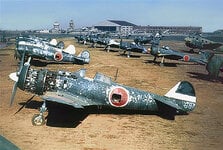Navigation
Install the app
How to install the app on iOS
Follow along with the video below to see how to install our site as a web app on your home screen.
Note: This feature may not be available in some browsers.
More options
You are using an out of date browser. It may not display this or other websites correctly.
You should upgrade or use an alternative browser.
You should upgrade or use an alternative browser.
Japanese aircraft paint
- Thread starter FMATAS
- Start date
Ad: This forum contains affiliate links to products on Amazon and eBay. More information in Terms and rules
More options
Who Replied?This is just a guess, but from almost 50 years experience with automotive paint I've learned there is a optimal paint thickness for any paint.
Too thin, and the paint doesn't have enough material to provide UV protection, the sun breaks down the paint, and it looses adhesion.
Too thick, it becomes brittle, and becomes less flexible than the surface it's expected to adhere to.
I suspect in the Japanese, in their constant attention to excess weight, ( the thicker the paint, the more the coating weighs) maybe they just didn't apply the paint thick enough for good long term UV protection from the sun.
And also maybe with their constant material shortage of a lot of strategic resources, maybe they just didn't see the need to waste premium materials on paint for aircraft that are only have a short service life anyway.
Too thin, and the paint doesn't have enough material to provide UV protection, the sun breaks down the paint, and it looses adhesion.
Too thick, it becomes brittle, and becomes less flexible than the surface it's expected to adhere to.
I suspect in the Japanese, in their constant attention to excess weight, ( the thicker the paint, the more the coating weighs) maybe they just didn't apply the paint thick enough for good long term UV protection from the sun.
And also maybe with their constant material shortage of a lot of strategic resources, maybe they just didn't see the need to waste premium materials on paint for aircraft that are only have a short service life anyway.
GrauGeist
Generalfeldmarschall zur Luftschiff Abteilung
Also consider that in the tropics, the constant UV exposure, coupled with operating in harsh environments (coral is exceptionally abrasive) will cause paint to release - especially for aluminum surfaces, which is a difficult metal alloy for paint to bond to.
Poor application of paint in the field would be a factor too I think.
Pre and early war paint on Imperial Japanese aircraft was quite good I believe, the constraints and conditions mentioned in posts above as the war effort ramped up explains the paint issues not to mention the operational tempo units were subjected to.
Pre and early war paint on Imperial Japanese aircraft was quite good I believe, the constraints and conditions mentioned in posts above as the war effort ramped up explains the paint issues not to mention the operational tempo units were subjected to.
thunderbird
Airman
- 74
- Jul 8, 2009
Japanese didn't know that one needs to chemically etch aluminum before painting it, either by brushing with alodine, or better, dipping it into an electrochemical application similar to anodized processes we use.
SaparotRob
Unter Gemeine Geschwader Murmeltier XIII
Really? Mitsubishi came up with a (better?) duralumin for the Zero. They must have had some metallurgical staff familiar with the stuff.
How long had anybody in the world been painting aluminum for severe duty in 1940 ?
It had only been in limited use for about 20 years at the time.
It's 80 years later now, and some people still have problems with it once it's away from a factory setting.
It had only been in limited use for about 20 years at the time.
It's 80 years later now, and some people still have problems with it once it's away from a factory setting.
GrauGeist
Generalfeldmarschall zur Luftschiff Abteilung
Also, no matter how well prepped Aluminum is, it will not resist the elements for long without constant care, especially in a humid environment in direct proximity to salt air.
SaparotRob
Unter Gemeine Geschwader Murmeltier XIII
Those planes were rode hard and put away wet. The supply chain they had wasn't quite up to the task so perhaps paint was of lower urgency.
Barrett
Senior Airman
Late to the party but as a former modeler and warbird restorer/aviator here's a thought:
Nobody expected combat aircraft to last very long--there are probably internet sources on the subject. If the typical Lancaster lasted c. 17 missions (standard tour was 30) you get the idea.
Just FWIW.
Nobody expected combat aircraft to last very long--there are probably internet sources on the subject. If the typical Lancaster lasted c. 17 missions (standard tour was 30) you get the idea.
Just FWIW.
Users who are viewing this thread
Total: 1 (members: 0, guests: 1)

